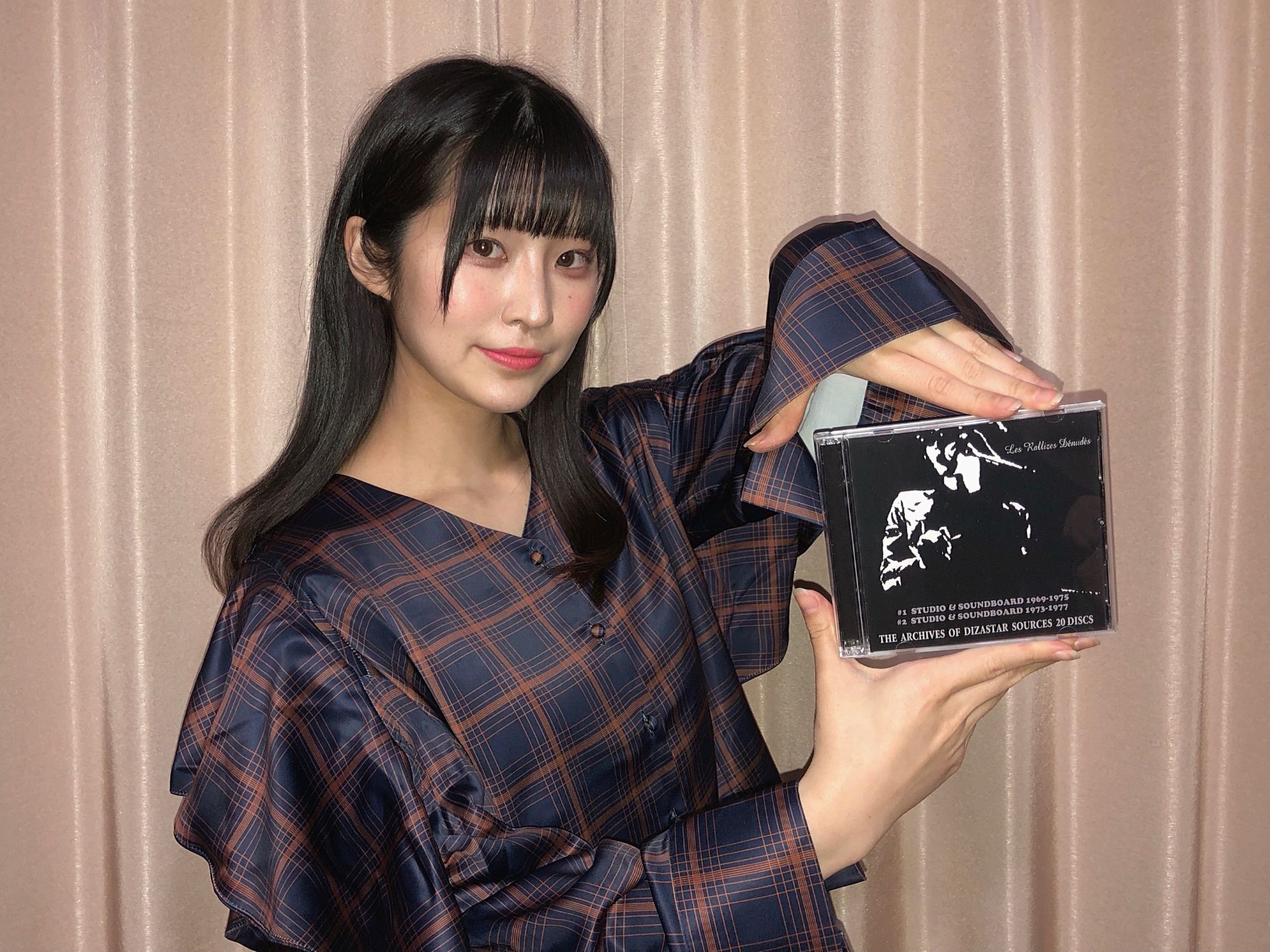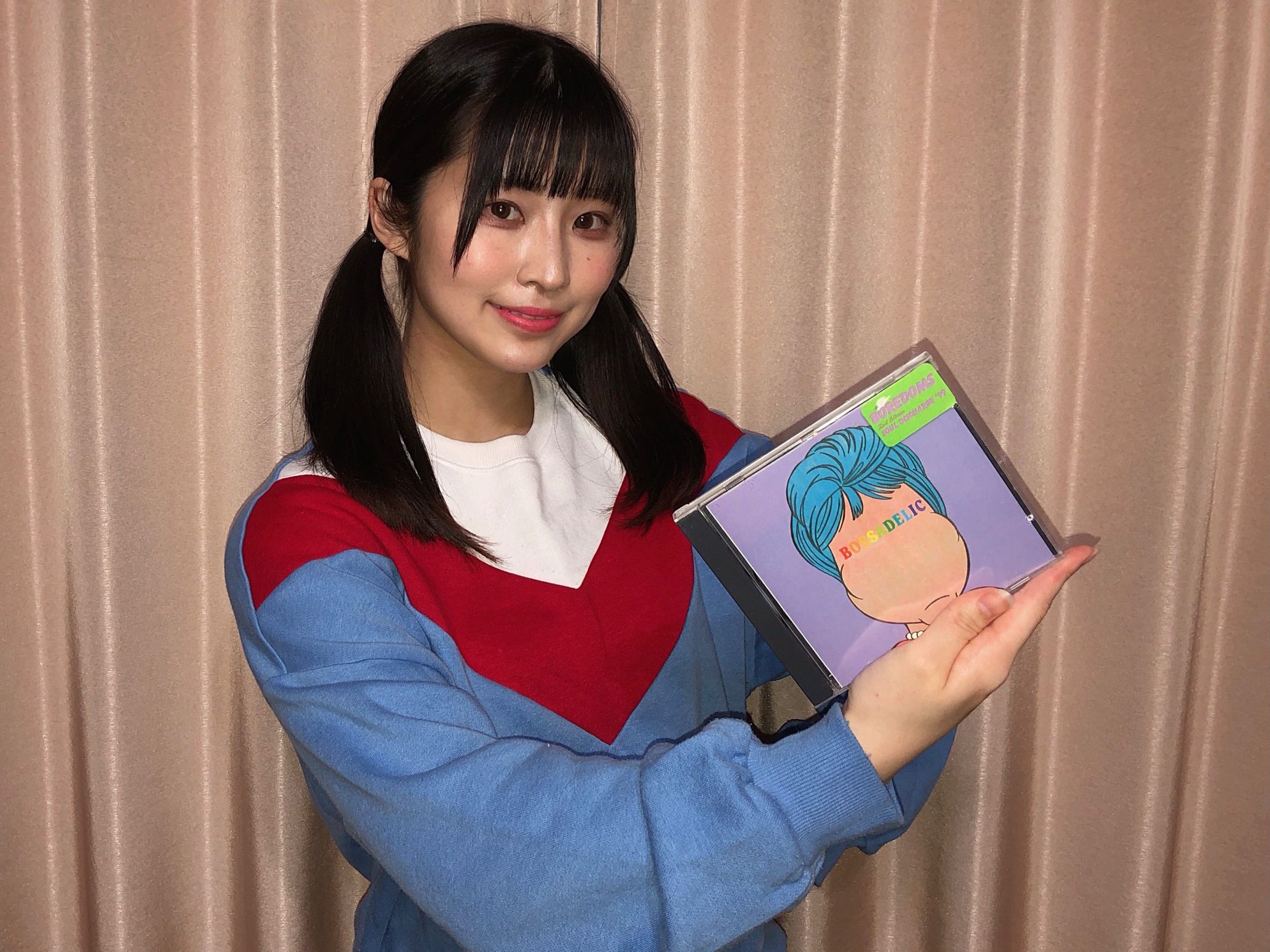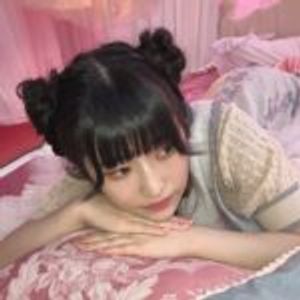Hello there!! My name is Yua Uchiyama from RAY. I work in the female idol group called RAY, while going to the university.
I enjoy listening to the masterpieces from all ages and countries every day, posting music reviews on Japanese SNS website note (https://note.com/__yuuaself__) on a weekly basis. My reviews are characterized by an intuitive comments on every single song in the albums written with little prior knowledge about them.
While I am choosing music randomly for the reviews on note, I would like to take this opportunity to introduce the enjoyment of listening to music and to offer chances of encounter with many different kind of music, under the theme of “tracing the history of the Japanese music .”
For this memorable first episode entitled “Japanese Psychedelic to Japanoise,” I am going to pick up and review three works: Les Rallizes Dénudés’ “THE ARCHIVES OF DIZASTAR SOURCES vol.1”, BOREDOMS’ “Soul Discharge ’99”, and Keiji Haino’s “Nijiumu”. (Uchiyama tends to review all the pieces on the albums, but it will be too much if I comment on all the songs of three albums, so the reviewing on all songs is limited to one album!)
Les Rallizes Dénudés’ “THE ARCHIVES OF DIZASTAR SOURCES vol.1” All songs review
This is my first time listening to Les Rallizes Dénudés’ music, meaning that this is the first encounter between Uchiyama and psychedelic noise. I already feel savageness from the band’s name. So thrilled!
DISC1: # 01 STUDIO & SOUNDBOARD 1969 –1975
1.Yoru yorimo Fukaku Kuroi Kanashimino Romanse (NOVEMBER 1975 SOUND BOARD)
The noise that was dimly ringing in the distance begins to approach with a splash. Slow tempo. Showa retro and melancholic atmosphere. Lo-fi. The vocal are barely audible though distorted. It was quite edgy that it doesn’t have a lyric sheet.. This unstable sound volume makes me keep wondering how I should adjust the volume dial. The hard and sharp noise from 2:55 hits and slashes my ears. The uneasy melody gives me the sense of sadness and pathos. Vocal intonation is unusual. It is filled with a bizarre atmosphere from beginning to end.
2. Yoru, Ansatsusha No Yoru (MAY 1975 STUDIO)
The noise is barking on a dark night. The blistering noisy sound turns into funny and cheerful at 0:43, reminding me of Japanese comic band the Drifters’ “ii yu da na” (literally meaning “good hot water”). The sound quality is amazing … I know I’m listening to something amazing. The noise eats up and covers over the cheerfulness. It’s like a weird Showa popular song. The words are lyrically placed on the melody. The striking guitar sound during the bridge is so cool. The most part of the bridge is hijacked by noise. From 7:49, it suddenly starts aiming for the other side of the roar. I was exposed to a lifetime noise.
3. Omae Wo Shitta (The Last One) (JUNE 1974 SOUND BOARD)
A melody starts so suddenly that I feel as if I am listening to the song from the middle of it. Sound quality seems to mirror the history of the song has. The vocal effect is just so intense. It echoes while deadly cracking. Oh, my ears hurt. Ears…! !! The noise sounds more dangerously than nails on a chalkboard. I feel as if my brain was pricked with ice pick. Noise remains in my ears even after the song has finished.
4. Zoka no Genya (JULY 1974 STUDIO)
Relentless noise from the beginning. Heavy-footed slow tempo. It feels like it is cutting a chunk of concrete. My ears are torn by noise. Unlimited aggressiveness. Loosely unbalanced vocals.
5. Improvisation (DECEMBER 1969 STUDIO)
Unlike the previous tracks with high-pitched noise, it has the thick noise that shakes the ground. Is it improvisation as the title suggests…?
6. Dansho (WINTER 1970)
The kindness coming after the violence is scary. The balance between the carrot and the stick. Although the album has significantly higher rate of stick, it makes carrot tastes even sweeter. It also sounds muffled, but the vocals are gentle and soft. An occasional glimpse of noise makes me gird for the greater ones. It has floating sensations as in a dream. A sweet and sad melody.
7. Kuroi Kanashimi No Romanse (SEPTEMBER 1975 STUDIO)
Another version of the first song that is not “deeper than the night”. With all the thorns removed, it sounds quite calm and feels like a different song. Sorrow is leaking out. Melodic. The guitar roars melancholically from 3: 07. Frailty and subtlety appears on and off through the strength.
DISC 2: # 02 STUDIO & SOUNDBOARD 1973 –1977
1. The Last One (JULY 1973 STUDIO)
It’s just bombing, bombing, noise and noise. Fieriness. The squealing noises from the guitar is so cool. It makes me unconsciously bend my torso backward. Even in the intensely chaotic sound image, a melody surely exists. I find myself excited with how the long bridge in the middle goes. It picks up a faster beat rom 7: 21 and plunge into the whirlpool of noise. I become enclosed by vocals echoing like voice from heaven.
2. Tori No Koe(JUNE 1974 SOUNDBOARD)
A dubious guitar reverberates unconstrainedly. Fantastical. High-pitch noise coming over so suddenly at 1:06 is dangerous. Down yet beautiful. A deeply reverbed vocal that sounds like a phantom bears divinity. The momentum of distorted guitar makes reality more and more ambiguous.
3. Shiroi Mezame (OCTOBER 1976 STUDIO)
A ray of light shines in, like a salvation … The sound of a guitar that glitters so brightly that it seems to melt. Vocal is like a swaying water surface. It sounds like a woman’s voice. Sounds from 1: 52 is scary and dangerous! I was shocked to feel a sign of danger. Noise comes in at 2:26 as I expected. Destruction. The atmosphere remains unchanged, but it is quietly eroded by unrest.
4. Kuroi Hanabira (JULY 1974 STUDIO)
A majestic ritual-like melody heard after eight seconds of silence. Somehow I feel “Japaneseness”. Each note of the guitar is thick and melodic. Perhaps because the drums is not audible, the sound isn’t tight and seems to spread forever. Though it is quiet, it feels like the clipping noise reaches a limit. A light sound of drum is heard from the second half. It ends with a 30-seconds silence.
5. Yoru Yorimo Fukaku (FEBRUARY 1976 STUDIO)
It sometimes gets deeper than night but other times not… Even though the sound is not intense, it is distorted and a sound of guitar gains its aggressive capability. The vocal effect is still strong, which increases the psychedelic feeling. The only way to survive a bombing noise strummed from 1:30 is to surrender to it. The sad and melancholy sound and the flood noise are attacking me alternately. For some reason, I feel seductive charms in this song. Even though I have already been exposed to the noise of a lifetime in DISC1, the human noise tolerance exceeded the limit in the middle of it. Violence of noise. Noise is violence. The song ends when I am swallowed up by the chaotic noise and become one with the noise.
■Artist memo
Les Rallizes Dénudés started their career in Kyoto in 1967. Outside of Japan, it is mainly known as their French name “Les Rallizes Dénudés”. It is a legendary group that has been often described as “the best psychedelic noise band in Japanese rock history.”
The sound quality was incredible… It feels like I’ve listened to historically very valuable materials. In fact, the production volume of this album produced was extremely small, so it’s not so far from the truth! I did all in my power to take a soul left by an urban-legend like group, described as “the most mysterious existence in the history of Japanese rock”.
The structure consists of intense noise and a sweet melody drifting in the background of it sounds creepy. While I think it is dangerous, I feel like I want to go deeper. It’s like a carnivorous plant, attracting insects with sweet nectar and eating it when it comes close. This is psychedelic noise …
With the roaring psychedelic noise that sticks to your ears once listening to it, everyone should definitely go to the other side of the roaring sound.
Next, I will listen to BOREDOMS “Soul Discharge ’99”.
The only album from BOREDOMS I have listened to is “Pop Tatari”. “Soul Discharge ’99” is a work before their major debut, so it’s fun and scary to see what kind of initial impulses it contains. So excited!
…… It’s stuffed with a lot of powerful roars filled with overflowing impulses, as well as improvisational impulsivity, but I still feel a sense of unity from it. I would like to shake hands with myself who reviewed “Pop Tatari” as “an album that seems to be seriously playful”.
It gradually increases my desire for running wild. Pop and crazy expressions invite you to freedom, releasing your mind, and letting you think you can live as you like. It’s hard to find such a refreshing liberation of soul.
In “Z & U & T & A”, you can listen to some kind of human’s extreme mimicry of barking of dogs, whereas “TV Scorpion” features the sounds “Watata !!!!” that sounds like screaming of Ken in the Japanese comic Fist of the North Star. It’s surely performed by human, but screams like ones by a non-human beast often appear in this album. Every song is crazy, funny, yet super uplifting and cool … this is definitely discharging souls!
If you get lost in your life, please listen to it.
■ Artist memo
BOREDOMS is a Japanese rock band formed in 1986. While having members with rich individualities and a special musicality, it has experienced many changes in the membership and used a number of various stage names.
The band has been highly acclaimed from overseas. They have performed as an opening act for Nirvana’s national tour and been invited to many overseas music festivals.
Finally, I will listen to Keiji Haino’s “whether or not there is bleeding”.
This is the work of Keiji Haino. I have to confess that I have never heard of even his name. Everything including CD Jacket, CD itself is colored with black. While feeling uneasy, I’m thrilled to hear what kind of music I hear from it!
…… This is a cursed CD.
Even if you introduce it that way, this countless numbers of sound images would make everyone believe it. A bottomless eerie paradise, a cavalcade of weirdness.
A small sense of incongruity fills the air, creating a sense of turmoil that seems to burst. Then, the darkness of about 53 minutes begins. I’m sure he speaks Japanese, but it doesn’t form the Japanese I know. Coupled with the sound in which a ghost story is about to begin, it already petrifies me with fears at that point.
When listening to the faint volume for a while, I suddenly hear yells and screams. To be honest, it’s worse than any horror film. This is Japanese horror … No, Japanoise horror!
Even after that, he constantly puts a sad cry on a mysterious melody and scatters grudges, but strangely, I start to see the beauty in it. After listening, I just have a feeling that you have listened to something you should not listen to, as well as a feeling that you should not step further. Okay, let’s protect myself …
(* In fact, in the Japanese TV program “Waratte Iitomo”, a person who bought some CD of Japanese pop bang B’z introduced it as a horrifying “curse CD” that had completely different content, and the content was different each time it was played, and it became a hot topic. However, it turned out that it was actually “NIJIUMU”. Even so, it’s too far from songs of B’z ..)
■Artist memo
Keiji Haino is a musician who has been active since 1971 and is one of the oldest persons in the history of Japanese avant-garde music. Since he released most of the records through independent distribution, and the number of works is very large, it is difficult to grasp the whole picture of his career. A charismatic presence that has given birth to numerous followers worldwide, including Sonic Youth’s Thurston Moore.
Just as there is the word every person is different, Every noise is different.
Through the three works, I experienced “Japanese psychedelic noise to Japanoise”. I was just amazed at how wide the range of expressions is and it was an exciting experience.
Some are bombing roaring noises, some are delicate and sensual noises, some are tinnitus-like noises, and some are hallucinatory and euphoric psychedelic noises. Just as there is the word every person is different, Every noise is different.
Although there are some works that have been delicately elaborated, I think their impulsiveness and improvisationality makes noise music an emotional expression that does not require words, and creates the wild and physical rhythm, which are very attractive.
The genre of “noise” may seem too difficult at first glance, but it’s just totally free. It is so free that I hold admiration for it. There are times when “the food I hated without eating was unexpectedly delicious when I tried it!”. So I would like people who dislike it without listening to it to listen to it.
Wow!! I got exposed to a lot of noise in this first episode! What kind of music will I meet next month … so thrilled! Don’t miss the next episode!




